Kathmandu: Between colorful Temples, blue Smog and the Afterlife.
November 18, 2023

"Is the temple on the other side of the road?" my boyfriend shouts as he stands beside me. Three thousand mopeds and motorcycles roar past the broken curb in both directions in a wild escalation of anarchy. Since there are no traffic lights or signs in Kathmandu, the torrent of traffic just does not stop. Like in never. A scene that makes the utter chaos of traffic in Naples, Italy, look like a stroll through a manicured English garden.
"Yes!" I yell back through the blue-tinged smog.
"Good, then we probably won't get there!"
To people from Western cultures, Kathmandu, the capital of Nepal, is like spring-loaded glitter bomb that bursts every two seconds, spewing gold coins, confetti, unicorns, dust, noise, gods of destruction, and indefinable fumes. It's not the city that never sleeps, but the city where you can't sleep, because at night your senses keep flashing and fireing because of the things you experienced during the day.
Monkeys scurry across colorful temples, prayer wheels clatter, and the ashes of the dead float in the river under the bridge.
For a week, we walk 20 miles through Kathmandu, crisscrossing up and down every alley that opens in front of us. Is it dangerous? Have we managed to see the city without ever crossing a street? And if not, what about life after death?
How to cross a road in Kathmandu

"We'll just start to walk! Just like in Italy!" I shout as I step out onto the street with knees trembling, knowing that it's not at all like Italy, but rather like someone moved the Indianapolis Motor Speedway to New Delhi.
A motorbike with a man, a woman and three children all on one seat comes speeding towards us. I keep walking. The family makes a fantastic, last second, but at the same time casual and practiced, swerve around us, slowing down seven other motorcycles in the process, while a taxi careens through a ten-foot-deep pothole and a tiny woman in a red sari uses our resultant butterfly effect to also scurry across the road. So that's how it works.
After crossing the first few streets with an underlying fear of death, I realize two things: a) we're still alive and on the other side of the road, and b) the Nepalese have a reaction time so abrupt that it explodes as it breaks the sound barrier.
Spoiler: We walked through the Kathmandu traffic tornado for a week and didn't see one single accident. Not even a scratch from a motorcycle on our elbows.
Monkey Theater at Swayambhunath
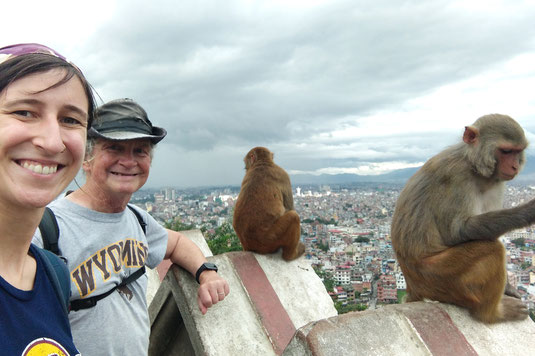
Time to focus on other things that—Dude! Did monkeys just jump exuberantly out of the trees into a roadside pond?
Water drips from their fur as they climb out of the pond, run along the railing, and jump eagerly back into the pond with elegant twists and turns. How cool is that? It somehow reminds me of summers at the outdoor pool in my hometown, and of myself as a child.
Why do we humans have to throw bombs at other humans when we could just have fun like the monkeys?
The monkeys in Kathmandu seem to have a kind of fool's freedom. Their control center seems to be the Swayambhunath Stupa: up the stairs, down the stairs, over the temple roof, a short stop to drink water from a golden basin, then on to the wall. Break. Philosophical view of Kathmandu.
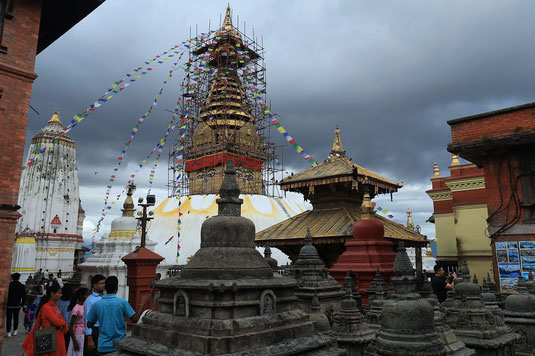
We stand next to flames spewing forth from a bowl, the monkeys in front of us, the all-seeing eyes of Buddha painted on a golden pillar of the stupa behind us.
A stupa is a dome made of stone which were originally used to bury Indian rulers, but now contain relics of the Buddha and important Buddhist monks and nuns. Like many other buildings in the Kathmandu Valley, the Swayambhunath Stupa was damaged in the great earthquake of 2015 and is still covered in scaffolding today.
Although Nepal is one of the poorest countries in the world and money for repairs is scarce, the people seem extremely hard-working and—as in many parts of the world—extremely hospitable and friendly.
One morning we walk through an alleyway where three men are chipping away old stones with pickaxes with great effort, and two evenings later, the street is newly paved with stone tiles. Completely. Finished. With a floral pattern.
With Helmut Kohl to Bhaktapur - World Heritage and earthquakes
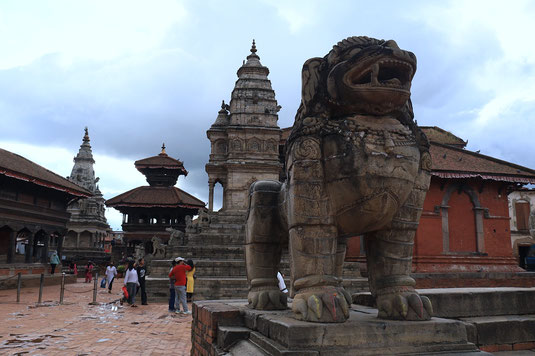
Speaking of the 2015 earthquake, it unfortunately left some Kathmandu Valley UNESCO World Heritage sites in ruins. At the centuries-old Durbar Square in Kathmandu, a worker hangs with one hand on a rope leaning over the roof of one of the many temples in the square. He checks every single shingle. Even though the earthquake occurred several years ago and much has been restored—thanks in part to international aid—the destructive power of nature is still clearly visible in the beautiful buildings.
We find the temple square in the much quieter town of Bhaktapur, one of the three royal towns in the valley, to be even more impressive than Kathmandu’s Durbar Square. From Kathmandu, it is about 40 minutes by an incredibly inexpensive taxi to Bhaktapur. And even though the road conditions in Nepal can take up to six hours to cover 60 miles, every taxi driver, bus driver, and guide here is always reliable and polite.
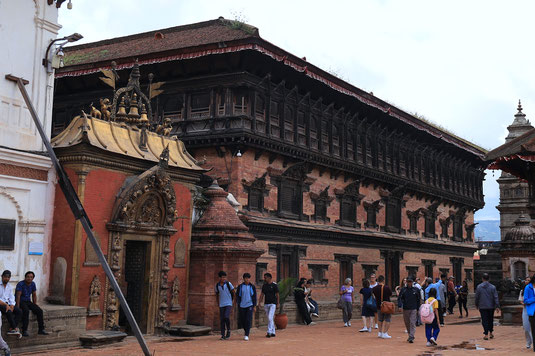
Bhaktapur contains not only The House of 55 Windows, which attracts architecture students from all over the world, but also a small pavilion with a German language plaque on the wall. I look twice. Does it really say something about Germany’s former Chancellor, Helmut Kohl? Helmut Kohl in Bhaktapur? What's he doing here?
Evidently Kohl’s administration gave money to rebuild the ornate pavilion—destroyed in yet another major earthquake in 1935—back to the original form. A few Nepalese stop and give me the thumbs up with a smile. Helmut Kohl! Germany!
My boyfriend nods. "Helmut Kohl! We call him German Buddha." Everyone is happy.
Aha! So the human monkey can rebuild things out of rubble as well as tearing them down into rubble.
And while we're on the subject: The most dangerous things in Kathmandu are sudden earthquakes and the choking smog (FFP2 mask revival!). Other than that, we never had a bad feeling anywhere at any time of the day. To be honest, I feel safer walking in Kathmandu than in Berlin or New York.
Pashupatinath: Public cremation and joy of life
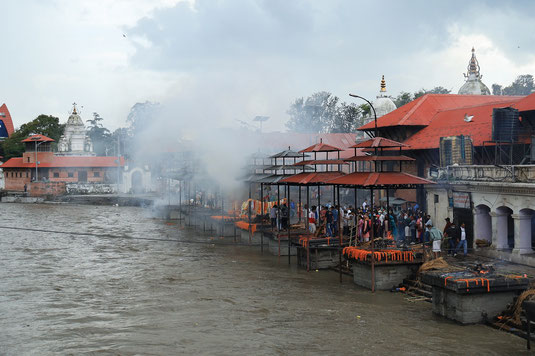
Among the many moving, spiritual, loud, and quiet places in Kathmandu, one place that touches me the most is the Pashupatinath Temple. The place where the dead are publicly cremated. Personally, I find the way we deal with death in Germany quite depressing. For Germans (and maybe Americans as well), it is best not to talk about death, not to look at dead people, just put a carved stone over a grave, and wear black clothes. Oh no, I can't relate to that!
In other cultures—such as Mexico or the Caribbean—there are colorful parades and colorful headstones with vacation photos and favorite objects of the deceased. People dance, sing, and celebrate the life of the deceased.
At the Hindu Pashupatinath temple, anyone—Hindu, Nepali, or tourist—can come and watch the cremation of the dead.
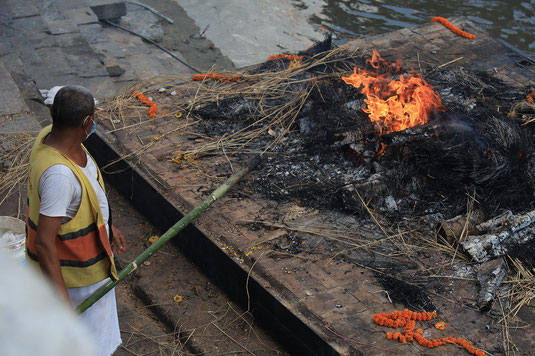
The bodies are dressed in the sacred color orange and then placed on a pile of wood. Relatives perform rituals before the deceased is set on fire. It burns for about three hours. The ashes are then pushed into the Baghmati River, which flows into the holy Ganges. The soul of the person has long departed before the waters reach the Ganges, and the body has been reunited with the elements of nature.
We observe the burning piles on the banks of the river while on the opposite bank, women allow bowls of flowers to slide into the water. Impermanence of life is something my boyfriend and I have dealt with openly for a long time because of our age difference. Silence about death is not an option. Sometimes we must face the things that frighten us the most so we can process and understand them, at least a bit.
It is moving to see how naturally the Nepalese deal with death. Will we be reborn? Will we meet a god? Do our loved ones accompany us through life as guardian angels after their death? Is there simply nothing? These are questions that everyone must answer for themselves, and places like Pashupatinath are an open invitation to seek answers.
Upcoming soon: reports about our night in the jungle of Chitwan National Park and our Himalayan Trek.





